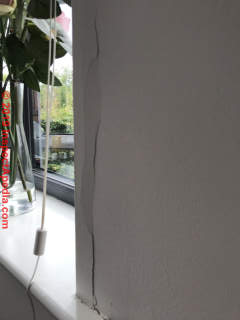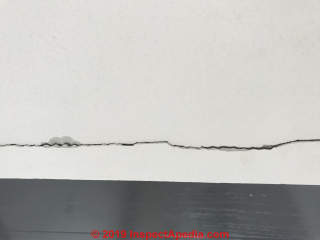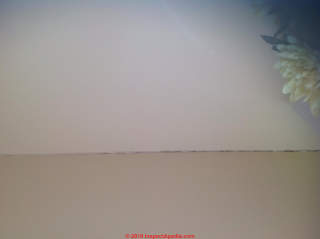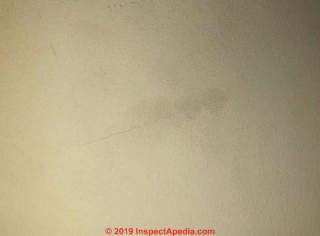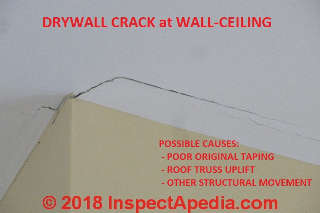 Drywall Crack Diagnostic FAQs
Drywall Crack Diagnostic FAQs
Q&A on cause & prevention of cracks in plasterboard or gypsum board ceilings & walls
- POST a QUESTION or COMMENT about plasterboard cracks, drywall cracks, gypsum board cracking & movement
FAQs about the causes of and cures for drywall cracks in ceilings or walls.
This article series describes the common causes of all types of cracks that appear in drywall or gypsum board or plasterboard walls & ceilings in building interiors.
InspectAPedia tolerates no conflicts of interest. We have no relationship with advertisers, products, or services discussed at this website.
- Daniel Friedman, Publisher/Editor/Author - See WHO ARE WE?
Q&A on Cracks in Drywall
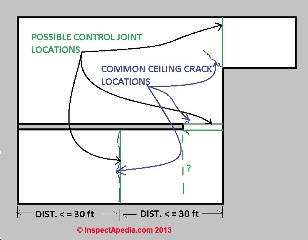
These questions and answers about the causes of drywall or gypsum board cracking were posted originally
at DRYWALL CRACK CAUSES & CURES - be sure to review that photo-catalog of types of drywall crack damage.
On 2019-07-11 by (mod) - what's causing the drywall cracks shown below?
Probably Kerry we're seeing bad tape joints.
But to make a reasonable diagnosis of the cause and significance of these cracks I'd need to know answers to all of the following
Drywall Crack Diagnostic Questions
What is your country, city, climate?
How old is the building and how old is the drywall and how old are the windows?
Do the cracks appear only around windows or also at other outside corners of the home?
Where else do these cracks appear? Are they only vertical? Are there horizontal occurrences?
Are there cracks that are diagonal?
Are there cracks not at these outside corners around window openings?
When did you first notice the cracks.
Look closely at the opposing sides of each crack for any signs of vertical movement (which I suspect is absent)
Are there any leaks? Drafts? Insect damage?
On 2019-07-11 by Kerry
Last one! Please check other 3 images. The builder seems to think a plasterer can skim over it lol! What is causing this? Huge separation in drywall, I also have closed nail pops and a very alarming ridge running horizontally the hall where my stairs are.
On 2019-07-11 11:30:04.232472 by Kerry.
Here are some bizzare cracks appearing around window and door frames in my home.
On 2019-06-06 14:10:09.254270 by Fernando Funes
Good morning. In the following floor plan interior condition, and taking into account that both surfaces (render and gypsum) will be paint finish: how to avoid cracks along gypsum/render encounter? Expansion joint tape/paper, caulking, both, other method...?
Thank you in advance.
IMAGE LOST by older version of Comments code - now fixed. Please re-post the image if you can. Sorry. Mod.
On 2019-04-23 2 by Anonymous
the crack areas are along the ceiling where the walls that have cinderblock that separates each apartment on bathe sides. They are sporadic throughout each room and not just around the corners.
Like the ceiling is cracking some areas the paint looks so thick and heavy. It doesn’t look like settling in my opinion. Some reason my apartment has the most of that black thick looking stuff.
My neighbor 2 doors down has ceiling cracks very defined however, hers is in middle of kitchen living room area like if it adjusts too much, it just might break through.
This is one picture I took in the water heater closet between kitchen wall and my bedroom closet wall.
IMAGE LOST by older version of Comments code - now fixed. Please re-post the image if you can. Sorry. Mod.
On 2019-04-23 by CJ Noelani
Same lit’l black things on shelving over my water heater which is inside a closet behind remodeled kitchen sink wall
IMAGE LOST by older version of Comments code - now fixed. Please re-post the image if you can. Sorry. Mod.
On 2019-04-23 by Anonymous - scared of drywall dust
I’ve tried to get things looked at all with red tape, runarounds, even after lease renewal inspection recently. Maintenance person keeps stating *what issues are* that clearly makes no logical sense & completely untrue. Which is extremely frustrating and goes nowhere now for over a year.
He fixed kitchen double sink due to leaks & now water from other side of garbage disposal is spitting up at me if I’m running water down the disposal side, he fixed peeling paint in bathroom where the wall and tub meet, it’s peeling even more, the stuff he used is drying with water marks and crumbled powder substance on the floor,
During management inspection not health dept since they haven’t been here I’m told for more than 5 years, that these cracks along the interior walls at the ceiling/wall edge is nothing, yet the cracks are getting more defined with black pebbles on top of the kitchen upper cabinets where that black stuff is.
Accused me of putting food in kitchen disposal even tho I do not, maybe rarely does a lit’l bit of food goes down but I run water, turn on disposal
I use baking soda mostly for cleaning in which he told me baking soda will eat the plastic piping indicating that I’m the one causing the issue by doing that and any plumber would tell me that.
That I should only be using *hot water* to clean, nothing else. That doesn’t fully make sense to me. I once used blue food coloring to see where the water is going on the counter tops since they’re not sealed, after first time he disputed me and it showed the leak in bathroom sink
Whoever remodeled in 2010, made new walls I discovered as i was doing fueng shui to place a mirror. So the tub was replaced, smaller in size, don’t know if the tile was removed or not since the wall that goes with the tub now covers but I don’t think they sealed the 2 or if you’re supposed to or not since I get same black pebbles coming out the space between them
Only a few here and there. There’s many times I can smell foul rotten eggs, musty that hurts my nose causing headaches
I can’t afford a whole bunch of testing since I’m a single mom on disability dealing with health concerns of my 5 year old even more so since we moved in. So I’m trying to narrow down so I can test least expensive but effective way. The maintenance person is not helping by turning it back at me.
Sorry so long. This site has been very informative and helpful in many ways. Mahalos
I’m adding another pic of stated roof/wall over my kitchen cabinets
IMAGE LOST by older version of Comments code - now fixed. Please re-post the image if you can. Sorry. Mod.
On 2019-04-22 by (mod) -
CJ
Those look to me like ceiling-wall cracking at a bad tape joint. Can you clarify where these cracks occur?
The "black stuff" may be dust deposition from air leaks; if you see signs of water leakage then mold would be more suspect. One needs a closer look.
IF the particles you are "cleaning" are a respiratory irritant
AND
IF you are "cleaning" by using a home vacuum cleaner that is not HEPA-rated,
THEN
it is likely that you are actually increasing the level of airborne dust, thus making for more respiratory distress;
If that's the case and if you must clean by vacuuming it may be worth investing in a top quality HEPA vacuum cleaner.
But it would make sense to have a more-expert on-site look at these cracks and at the building for leaks, structural damage, IAQ issues, etc.
On 2019-04-22 by (mod) -
CJ
Those look to me like ceiling-wall cracking at a bad tape joint. Can you clarify where these cracks occur?
The "black stuff" may be dust deposition from air leaks; if you see signs of water leakage then mold would be more suspect. One needs a closer look.
On 2019-04-22 by CJ Noelani
Another photo. Now I cannot clean these areas without having weeks of respiratory issues I don’t use chemicals except bleach and that’s only for few things and not very often.
IMAGE LOST by older version of Comments code - now fixed. Please re-post the image if you can. Sorry. Mod.
On 2019-04-22 by CJ Noelani
This is early photos from a year ago. I’m concerned about the cracks but more so the black stuff that is slowly gathering more along with the crack where there’s cinderblock walls. I have 3 different photos. I am on top floor.
IMAGE LOST by older version of Comments code - now fixed. Please re-post the image if you can. Sorry. Mod.
On 2019-02-24 by (mod) -
Okay do keep me posted on what you're told and we may be able to offer some suggestions.
You want to look at your foundation for signs of cracking or Frost heave.
On 2019-02-24 - by (mod) -
winter-only cracking in drywall - frost heaves?Okay do keep me posted on what you're told and we may be able to offer some suggestions.
You want to look at your foundation for signs of cracking or Frost heave.
On 2019-02-23 (mod) -
You need an onsite diagnosis as i cant know enough to diagnose from the photo. Drywall cracking that appears cycly only in winter could be due to frost heave.
On 2019-02-22 by Michigan Re
Our Home is Located in Michigan, USA.
During Every winter i see Drywall cracks on the celling & wall joints & the cracks are more then hairline cracks ( Clearly visible in dark night also).
Also dry wall Tape pop up from ceilings & Wall .
But they disappear in Summer .
So does this trouble because of Low Humidity in the house during winter or I need to increase insulation in Attic ?
The photo is Two wall corner joint Crack .
Thank you.
On 2019-02-06 (mod) - diagonal cracking in drywall
Strange case of diagonal cracking in drywall - not one I can confidently diagnose by text.
Could be something as odd as damage during installation, not showing up until now, perhaps with some flexing from stress in the drywall just in how it was screwed or nailed to the studs.
I'd tape the crack with mesh drywall tape, spackle it, and repaint it.
If the crack reappears I'd inspect the wall structure and interior cavity.
On 2019-02-04 by ghostrider1400
I have a gable roof if that makes any difference. 80% of the house is stained concrete so I can see the slab. No cracks that I can see.
The room itself is carpeted, but all surrounding rooms have no floor coverings at all. I don't travel that area of the attic very often. Nothing is stored there even.
That being said, the home was finished late 2015 so my only other though is that the home is going through the "normal settling) phase.
The wall pictured is on the outside of a closet.
The wall opposite has no matching crack or sign of stress. I would imagine if the framing members were moving that we would see the same thing on both sides.
Could be wrong. I suppose I wonder the same most as to whether I should be concerned.
On 2019-02-04 (mod)
I don't think a male pop would cost diagonal cracking and drywall.
Building settlement, slab hearing, even traffic in the attic or on the ceiling above conceivably could cause such damage although it's not within my experience.
On 2019-02-04 by ghostrider1400
thanks for the response. I have rafters and no roof trusses. My only other thought was simple damage to the drywall surface. But it is still such an odd shape. I also wondered if a nail pop could somehow do this as as opposed to a clean push through.
On 2019-02-04 (mod)
Justin
I'm puzzled too. A drop in indoor humidity would not normally make drywall crack diagonally unless the material had been previously very wet.
Typically diagonal cracks indicate downward or rarely upwards movement in the supporting structure.
Often we see a ceiling crack like the one in your photo when loading from above flexes a poorly-taped drywall joint.
Does your home use roof trusses?
On 2019-02-04 by ghostrider1400
Photos for the comment under Justin. Also, this is a traditional wood framed home on a slab. The picture shown is on an interior wall under a light switch. The crack is hairline and the middle seems to sink when pressed on. I'm guess the board behind it is broken here.
On 2019-02-03 by Justin
Would there be any reason for diagonal cracks to appear on the face of a wall where it doesnt originate from the corner of a door or window frame? I'm wondering if this is caused by changes (specifically a drop) in humidity.
On 2018-10-26 by (mod) - why does a wall that was fine suddenly crack?
Alexander
You ask an excellent diagnostic question.
If you are absolutely certain that the cracks that you see your structure are sudden cracks appearing in an older surface of a wall or ceiling,
then you should be looking for a cause for structural movement.
While there are some odd cases that can cause cracking from above such as a roof truss uplift problem, most often there will be a problem below the area where the cracking is appearing.
Start at the building foundation and work your way up through the structure looking for evidence of damage or movement.
without having a shred of information about the building, it's type of construction, the site, or the even the country and city where it is constructed I can only give the most general advice.
I would probably be looking for foundation settlement or movement from some external cause and if the foundation is perfectly intact I would probably be looking for a rod or insect damage if it's a wood frame structure.
On 2018-10-26 by Alexander
would like to know why a wall that has been intact for some time ,develops cracks and they widen quickly
On 2018-08-10 by (mod) - drywall finish pops off at expansion joint
Mike
If they are truly Expansion Joints and you applied joint compound over them that I would expect it to crack or pop since that's a point that needs to be flexible.
On 2018-08-10 by Mike B
Why is the drywall finish popping off by expansion joints ?
On 2017-09-01 by (mod) -
Hennie,
To have space I repeat your question and offer a more detailed reply at the bottom of the
article DRYWALL CRACK CAUSES & CURES.
Take a look and we can continue from there. If you can send me photos of the damaged RhinoBoard please do so using our email found at the page bottom CONTACT link
On 2017-09-01 by (mod) - repairing using RhinoBoard - from GypRock Saint Gobain SA
Hennie,
Before suggesting a repair we want to know the cause of the cracking and we need to know (we meaning you mostly with some encouragement from the sidelines) if there is damage to the structure behind those cracks.
Otherwise a cosmetic repair may be wasted and a more-serious problem such as a leak, structural damage from loading, rot, or insects, may need to be repaired.
If you're using the RhinoBoard that's a product of GypRock Staint Gobain in South Africa (or similar) we're talking about a plasterboard that uses a foamed or aerated gypsum core bonded to paper liners: ivory coloured on one side and tan-brown on the other.
Rhinoboard is non-combustible and is used on ceilings and walls.
Rhinoboard is sold square-edged and in tapered-edge formats, the latter making it easier to tape and plaster over joints before painting in what the manufacturer calls a monolithic finish as in the Gyproc Drywall System.
So you could remove peeled loose coating, skim coat the peeled areas with joint compound, then tape cracks and joints using a fibreglass mesh tape, then coat with joint compound out 18" wide across the crack to hide the damage.
But as I intended to emphasize that work would be wasted if we don't first diagnose the cause of the trouble you are seeing.
Besides cracking, the peeling could be telling us there are roof leaks to be found and repaired, and it could hint that there is a mold reservoir in the roof cavity. If I were repairing a Rhinoboard ceiling with those conditions I would
- make a test cut into the ceiling to inspect for water, leaks, mold, in the most-damaged, most-suspect areas.
- inspect the roof for leaks
- hold off on cosmetic repairs until those questions are answered.
If you want to send me photos of the condition for comment use the page top or bottom CONTACT link and I may have more specific advice I can offer. Also it would help to know the country and city where your building is located.
I'll be sure to include any reference documents, contact information etc. for RhinoBoard in the REFERENCES section at the end of this article.
On 2017-08-31 0 by Hennie
I have a flat roof and have problems with cracking and peeling ceilings. How do you repair it. It is rhinoboard. Please help
On 2016-12-16 by GlenP
I have home built in early 1990's. In one bedroom the drywall in the ceiling at the joints is getting soft and breaking through. One spot was under a dormer, where paper wasps built a nest in the attic space. I repaired by cleaning out the nest and adding insulation before patching the drywall.
The other area is at a joint in the celling. There is a slanted ceiling and the softening area is at the point were the inside wall is closet to the roof. Do I need to add more insulation between the roof and the junction of the wall/ceiling to stop the drywall from softening and breaking through?
On 2015-05-13 by (mod) -
Youssef
use our email found at our page bottom CONTACT link to send us some photos for comment.
Cracking appearing at joints between drywall sections typically occurs because the joints were not properly taped and covered with compound. Less often there may be other causes such as framing movement, shrinkage, or other defects.
On 2015-05-13 by Youssef H.
AM FACING BIG PROBLEMS WITH THE CRACKS APPEAR ON THE GYPSUM BOARD JOINTS AFTER PAINTING
sometimes cracks appear before painting on the gypsum joints between the two boards
can you please inform us what are the main reasons it's make all these cracks specially we are foaling in hard argument with the paint subcontractors and clients as well my email is youssef.halabi@hotmail.com
On 2015-03-24 by (mod) - building movement caused drywall cracks: Miami Florida
Fair question, John but not one I can answer by E-text. Unusual building movements such as in an earthquake certainly cause cracks. Normal wind exposure in a building constructed to local FL standards? What does "the building moved excessively" mean?
Try this: go next door to your neighbours: if the building moved "excessively" then something's wrong or unusual and I'd expect cracks to show up in other apartments situated like yours.
Keep us posted.
On 2015-03-24 by John
I am having my apartment remodeled in Miami Beach. I have done a soffit ceiling in the living room and after a heavy storm it has cracked on several areas.
The contractor tells me it's because the building moved excessively. Is this probable or can it possibly be a that the job was not done correctly? Thanks for your comments.
On 2015-03-16 by Nance - cracks due to sinkholes in Canada
We're from Canada. I don't hear of many sinkholes here. I'd have to research that more.
On 2015-03-16 by (mod) - cracks after house lifted - nearby well drilling
NAND,
Before anything else you need an onsite engineer who is familiar with foundation and structural damage to advise if the home is safe to occupy.
Tell me where you live. Are you in an area prone to sinkholes?
On 2015-03-16 by Nance
Our house lifted up from its foundation last July 2014. Prior to this our neighbour had an open foundation hole for a long time.
A summer, winter and spring. The day they had their well drilled is when our house lifted off. I was home with my kids at the time.
The event was unforgettable. The roof noises were great and much popping and cracking of structure. My son's basement bedroom door was jammed and he couldn't get out during the event.
He had to crawl out his window. In the basement were sounds of air swooshing/ water sounds.
My favourite was the sound of what I describe as a wheelbarrow of gravel or nails being dumped on the basement floor.It was crazy!!! As a result left with much damage and our insurance will not cover it.
A crack in foundation wall and in the basement floors. Countless pulled gyproc screws.
Corners of our walls up and downstairs are pulling away from each other from ceiling to the floor. This has me worried. Things seem to be still changing. I'd appreciate any information you may have. Thanks
On 2015-02-10 by (mod) -
I wonder about "piers added ... so no problem" - after all if someone had to add foundation support there must have been some problem that was being addressed.
About removing a wall, even a non-load-bearing wall can bear unanticipated loads; on removal the building could be affected. So would "pounding in tight" a new wall - between floor and ceiling; that last would be the first guess we'd hazard.
Really one can't diagnose a structural problem by e-text, all I can do is suggest what to look-at. Perhaps by noting the location of wall-ceiling separation you can make a reasonable guess of what's going on.
If the ceiling/wall separated above your tight-new wall, that's suspect.
If the floor was and remains level and is not sagging that tends to confirm our suspicion of the new wall.
COnversely if the floor is down or the foundation is settling, then that can also explain wall/ceiling separation.
On 2015-02-07 by Rick
I have a single story home, it had exterior foundation piers added in 2009 so no problem. I purchased the home Sept 2014, upon move in we removed a wall that was NOT load bearing, but we added an L shaped wall and he really pounded it in tight.
With in less then two weeks we now have 1/2 to 3/4" separation between the walls and ceiling, can this be caused by the pushing up on the trusses from this new wall?
The trusses run front to back and this wall crosses in both directions and seems funny this happened right after the wall was removed and new one installed
On 2015-01-14 by Jordan
After 15 years, a humid summer resulted in damage to painted, knock-down ceiling. Result is cracks, peeling paper tape and slight bowing in many sheets between rafters at center peak where there is a small gap between ridge beam and drywall. Some mildew near gap. Was this caused by condensation between ceiling and roof?
Future prevention? No attic. Fiberglass insulation between 12" rafters. 6/12 light colored composition roof.
On 2015-01-08 by (mod) -
So apparently related to the underlying material: a fastening or shrinkage or similar error. Mudding any drywall joint without using tape (paper or fiberglass mesh for example) will often result in cracks following the joint.
On 2015-01-07 by It's a fine crack in a new piece of sheet rock added above a new entrance the width of a 2 x 4
It's a fine crack in a new piece of sheet rock added above a new entrance the width of a 2 x 4...I do not know if they taped it, cannot imagine they did not.
I am using the "best" green topped container mud.
Can I add a few ( the opening is about 4.5 ft)screws without taping and float the screws since I have no experience doing it. I have learned how to do a smooth wall in a round about way.
On 2015-01-07 by (mod) -
Steve:
The answer depends in part on where the crack occurs and how the plaster board was prepared.
If drywall joints were not taped I'd not be surprised if cracks appeared in those locations as the building and drywall or plasterboard dried out.
If drywall was installed in conditions of high humidity and heat or A/C in the building then dried the materials there might be slight shrinkage as well.
Some drywall compounds also are more shrinkage-crack resistant than others.
Building movement can cause drywall cracking in other patterns and locations.
Very wet textured paint may itself have been unable to bridge and accommodate its own shrinkage across un-taped drywall joints.
On 2015-01-07 by steve chase
plaster boards have a fine crack after applying a textured paint to it, what could the reason be for this?
...
Continue reading at DRYWALL CONTROL JOINTS or select a topic from the closely-related articles below, or see the complete ARTICLE INDEX.
Or see these
Recommended Articles
- DRYWALL, FIBERBOARD, PLASTER INTERIORS - home
- ASBESTOS in DRYWALL
- COATING TYPE CEILING & WALL SURFACES: CATALOG OF
- DOMTAR GYPROC ASBESTOS?
- DRYWALL & GYPSUM BOARD COMPOSITION & HISTORY
- DRYWALL CONTROL JOINTS
- DRYWALL CRACK CAUSES & CURES
- DRYWALL FINISH LEVELS
- DRYWALL INSTALLATION Best Practices
- DRYWALL INSTALLATION HORIZONTAL vs VERTICAL
- DRYWALL NAIL POPS & DENTS
- FROST HEAVES, FOUNDATION, SLAB
- GYPSUM BOARD GYP ROCK SHEATHING
- GYPSUM BOARD PLASTER LATH SYSTEMS
- METAL LATH for PLASTER
- PLASTER TYPES & METHODS in BUILDINGS
- PLASTER INGREDIENTS, MIX, PROPERTIES
- PLASTERBOARD / DRYWALL EXPANSION COEFFICIENTS
- TRUSS UPLIFT, ROOF
- WOOD LATH for PLASTER or STUCCO
Suggested citation for this web page
DRYWALL CRACK CAUSE FAQs at InspectApedia.com - online encyclopedia of building & environmental inspection, testing, diagnosis, repair, & problem prevention advice.
Or see this
INDEX to RELATED ARTICLES: ARTICLE INDEX to BUILDING INTERIORS
Or use the SEARCH BOX found below to Ask a Question or Search InspectApedia
Ask a Question or Search InspectApedia
Try the search box just below, or if you prefer, post a question or comment in the Comments box below and we will respond promptly.
Search the InspectApedia website
Note: appearance of your Comment below may be delayed: if your comment contains an image, photograph, web link, or text that looks to the software as if it might be a web link, your posting will appear after it has been approved by a moderator. Apologies for the delay.
Only one image can be added per comment but you can post as many comments, and therefore images, as you like.
You will not receive a notification when a response to your question has been posted.
Please bookmark this page to make it easy for you to check back for our response.
Comments
IF above you see "Comment Form is loading comments..." then COMMENT BOX - countable.ca / bawkbox.com IS NOT WORKING.
In any case you are welcome to send an email directly to us at InspectApedia.com at editor@inspectApedia.com
We'll reply to you directly. Please help us help you by noting, in your email, the URL of the InspectApedia page where you wanted to comment.
Citations & References
In addition to any citations in the article above, a full list is available on request.
- Gypsum Construction Handbook [purchase at Amazon.com] H17, Technical Folder SA920 and PM2, PM3 and PM4, United States Gypsum Company, 125 South Franklin ST., PO Box 806278, Chicago, IL 60680-4124,
- In addition to citations & references found in this article, see the research citations given at the end of the related articles found at our suggested
CONTINUE READING or RECOMMENDED ARTICLES.
- Carson, Dunlop & Associates Ltd., 120 Carlton Street Suite 407, Toronto ON M5A 4K2. Tel: (416) 964-9415 1-800-268-7070 Email: info@carsondunlop.com. Alan Carson is a past president of ASHI, the American Society of Home Inspectors.
Thanks to Alan Carson and Bob Dunlop, for permission for InspectAPedia to use text excerpts from The HOME REFERENCE BOOK - the Encyclopedia of Homes and to use illustrations from The ILLUSTRATED HOME .
Carson Dunlop Associates provides extensive home inspection education and report writing material. In gratitude we provide links to tsome Carson Dunlop Associates products and services.


